The Desktop Kabini Review Part 1: AMD Athlon 5350 (AM1) Tested
by Ian Cutress on April 9, 2014 8:00 AM ESTIGP Comparison, Synthetics
AMD’s graphics stack from top to bottom is all based on the Graphics Core Next architecture. This is an update from earlier VLIW implementations, offering for scalability from low power all the way up to high performance. At the heart of an AMD graphics system is the compute unit comprising of 64 GPU cores. Each compute unit can act independently, ensuring that multiple tasks can complete as quickly as possible due to multiple kernel dispatch across the entire core. In the Kaveri APU launch we were dealing with APUs that contained 6 or 8 compute units for 384/512 cores. With this level of performance, gaming at 1080p30 was possible on most titles depending on how the quality settings were configured. For Kabini, the entire range is given two compute units, with individual processors differing in clock speed.
With two compute units, we are not expecting much from the gaming aspect of these APUs in terms of ‘the latest’ titles. Our benchmarks in the next few pages show that even F1 2013 at 1280x1024 on low settings, unless the engine powering the game is basic, 25 FPS minimum is a hopeful target. This lack of horsepower may limit these APUs to Flash based titles, perhaps even some of the more reasonable Unity games. In AMD’s slide deck they quote games such as Minecraft, Lego Marvel Superheroes and Bastion as the sort of titles that a Kabini player should aim for.
There is some confusion regarding the naming convention of these integrated graphics solutions. Soldered on Kaveri parts designed for all-in-ones, such as the A6-5200, use the HD8000 naming scheme, such as the HD8400. The Athlon 5350 is analogous in design to the A6-5200 except for a 50 MHz speed bump and the name of the IGP – here this is designated as the R3 series. This is despite retailers who are currently selling this APUs and labeling them with the HD8000 designations.
Like Kaveri, the integrated graphics solution in Kabini features an updated Video Codec Engine and Unified Video Decoder giving hardware support for H.264.
AMD is also promoting their Picture Perfect solution, using additional post processing tools to increase video quality on the fly:
Also rather interestingly AMD is claiming an enhanced decoder for JPEG files. Given that one of the primary uses for a Kabini system might be for web access where JPEGs are standard, AMD has been promoting up to a 2x performance increase over a J2900 system:
AMD’s secret sauce, according to their slides, appears to be heterogeneous computing. This would be the ideal usage scenario for computing going forward.
GPU Synthetics
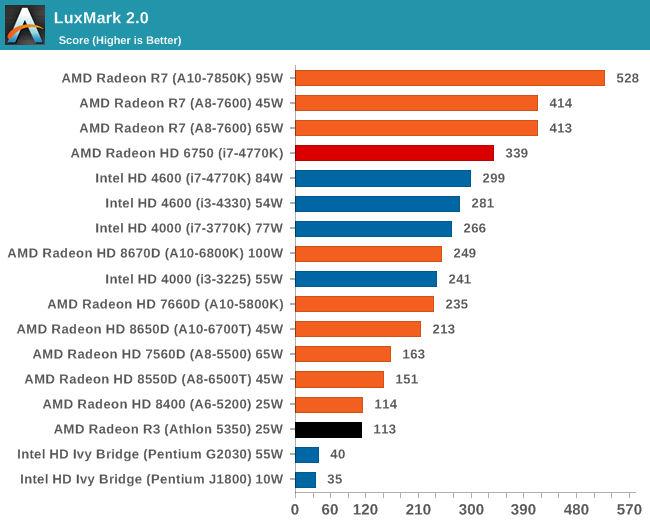
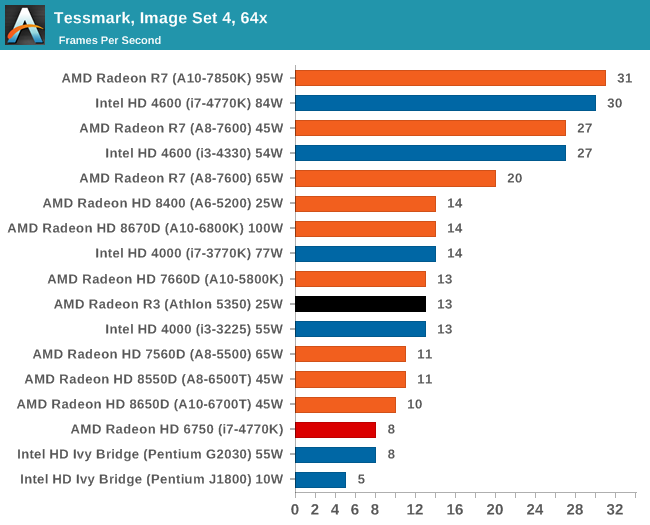


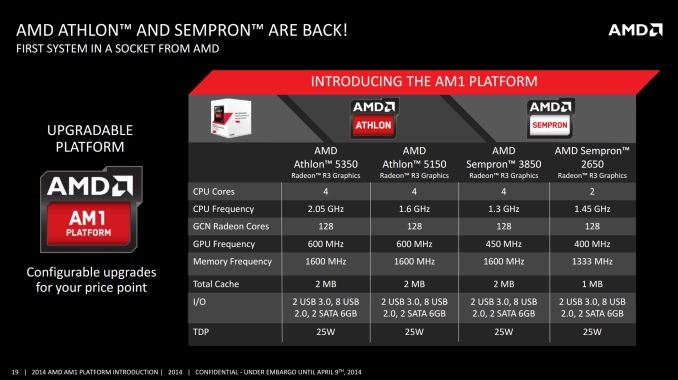
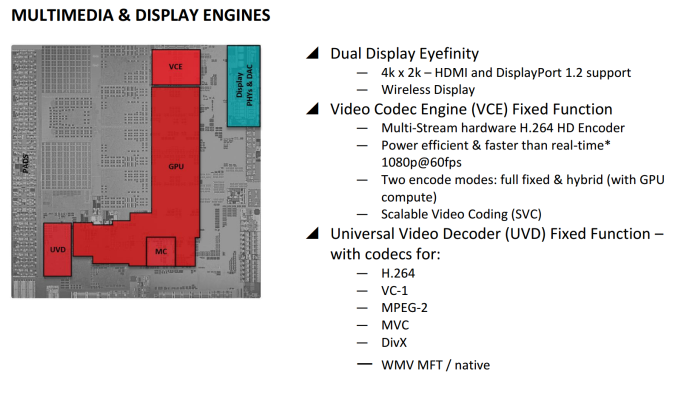
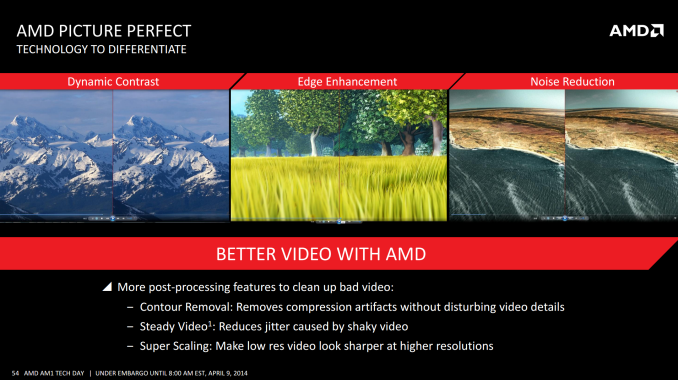
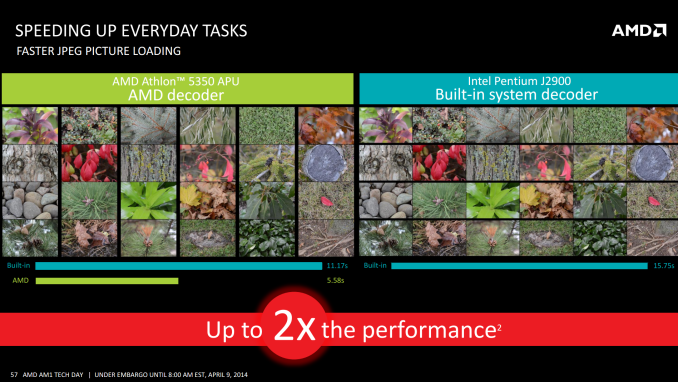
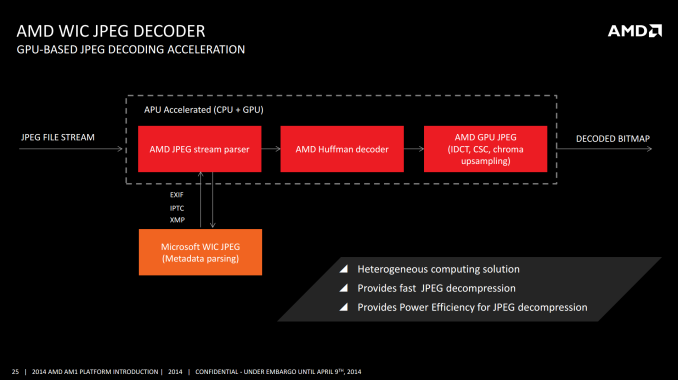








126 Comments
View All Comments
Medallish - Wednesday, April 9, 2014 - link
Well sadly it's not $35, but $59 But it does come with two extra Sata III ports, and the ability to plug a 19V DC directly into the boardhttp://www.newegg.com/Product/Product.aspx?Item=N8... Should be said the cable that comes along with it to supply drives with power directly from the motherboard, only supports 2 drives, so yeah if you do use that port you likely need to come up with an inventive way of supplying 2 additional drives.
If I were building a mini server though I'd likely to a little crazy and get this:
http://www.newegg.com/Product/Product.aspx?Item=N8...
6x Sata III ports and 1x mSata & 1x eSata. And then get some Richland or Kaveri APU as cheap and low power as they get with onboard GPU.
I'm sure you'll get a lot of other replies with even better suggestions.
Communism - Wednesday, April 9, 2014 - link
Lol @ those prices,37 USD motherboard:
BIOSTAR H61MGV3 LGA 1155 Intel H61 Micro ATX
http://www.newegg.com/Product/Product.aspx?Item=N8...
43 USD CPU/GPU:
Intel Celeron G1610 2.60GHz LGA 1155 Processor
http://www.amazon.com/Intel-Celeron-2-60GHz-Proces...
Desktop Kabini is DOA for it's intended purpose.
Medallish - Wednesday, April 9, 2014 - link
I love it when people trot out a H61 based board like it renders Kabini useless, completely missing the fact that it compared to Kabini misses a lot, with H61 you only get USB 2.0 and Sata II.And then there's that wonderful 55W CPU you put in there that I'm sure doesn't even compare on GPU performance to the Kabini and only is slightly ahead in CPU bench's.
I built a kabini system using this case:
http://www.chieftec.eu/en/chassis/itx-tower/ix-01b...
And the Asrock board:
http://www.asrock.com/mb/AMD/AM1H-ITX/
I got a board with a lot more functions, and an incredibly simple build thanks to the DC-In port, and still incredibly cheap. Kabini is like the perfect build for a lot of my family members who still can get use out of newer standards like Sata III and USB 3.0
meacupla - Wednesday, April 9, 2014 - link
Do you really think the presence or not of SATA3 matters in such a low end system?USB3.0 is nice, however.
Medallish - Wednesday, April 9, 2014 - link
Might not be a selling point telling someone with no clue, that it has Sata III certainly, but IO performance adds to the "feel", and on that front I would definitely say it can matter.fokka - Wednesday, April 9, 2014 - link
sure i'd prefer sata3 too, but the IO performance you're talking about isn't hindered much by sata2. max throughput is capped in half, yes, but once you go random rw, sata2 shouldn't be the limiting factor.MrSpadge - Wednesday, April 9, 2014 - link
Once you're transferring at 270 MB/s (SATA2) the feeling is pretty good. And during installs & loads the CPU has to keep up, too.rudolphna - Wednesday, April 9, 2014 - link
Well. Here is the thing. I have a Celeron g1610 on a mATX b75m board that together cost me $105. I use our for network storage and as a plex server which is real-time h264 encoding. I tested it with handbrake. Under handbrake h264 encoding using the igp for display, the g1610 pulled a maximum of 17w according to coretemp, not 55 or anywhere close to it. It generally runs sub 10w, when doing a single plex encode.Medallish - Wednesday, April 9, 2014 - link
I really wouldn't count on Software to get a accurate meassure of that, and TDP != Power use, it simply refers to the cooling requirement, I'm pretty sure the 5350 and 5150 don't use the same amount of power, despite them both having a TDP of 25W.frozentundra123456 - Wednesday, April 9, 2014 - link
Upgradability is nice, but the problem is upgrade to what. Right now there is no real upgrade path, and it is unknown what and when the next upgrade will be. Seems like another very niche product, like the rest of AMD APUs, trying to use the graphics to leverage an advantage against higher power consumption and mediocre cpu performance. So far this strategy hasnt really been successful, as the marketplace shows. That could change as more apps use graphics, but IMO single core performance (and power consumption in a small envelope like this) is still king.